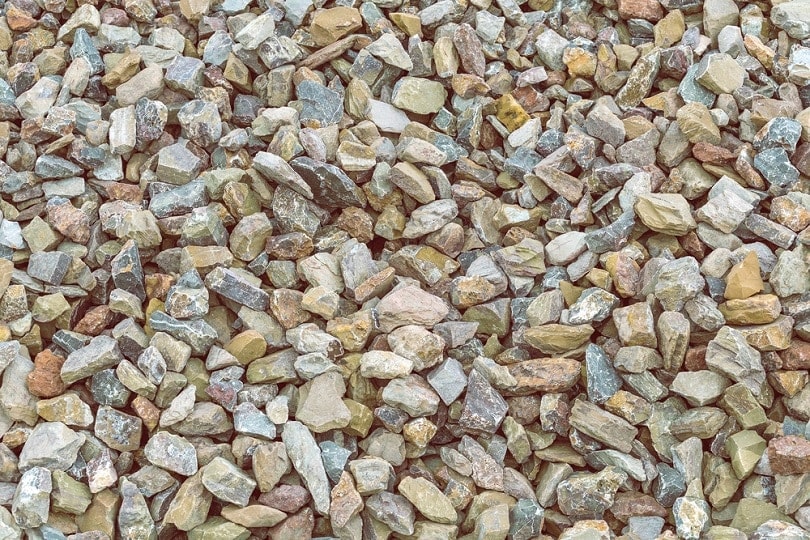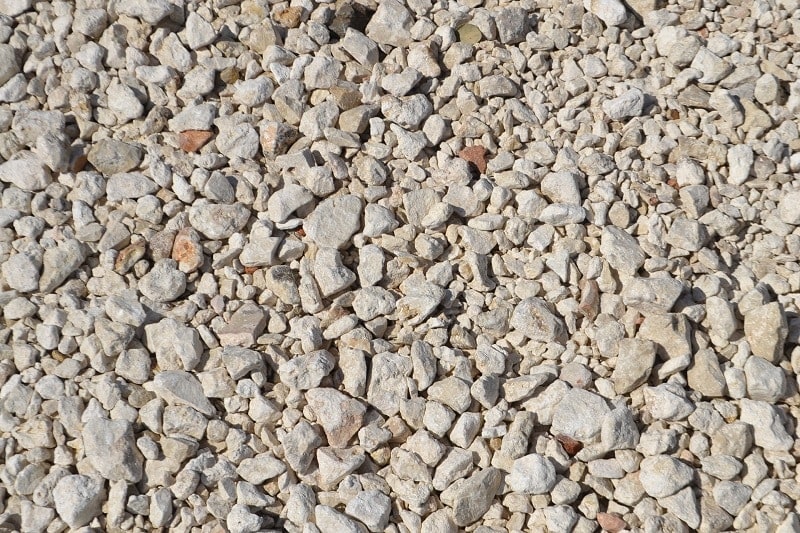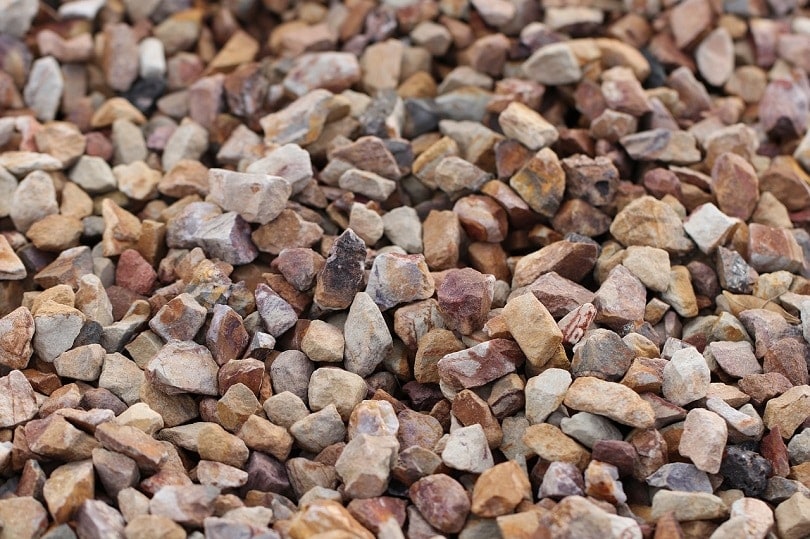10 Best Gravel Types for Drainage (Pros & Cons)
-
- Last updated:


No matter what type of landscaping feature you’re building, from driveways to French drains to planter boxes, you’ll need to ensure that there’s plenty of drainage. One of the best mediums for creating drainage is gravel.
But you might not realize just how many different types of gravel are available. While all gravel is made up of broken chunks of rock, not all gravel is ideal for drainage. If you use the wrong type, you might not get the necessary drainage, resulting in pooling, flooding, and worse.
To help you determine which gravel is best for your project, we’ve put together this list of the best types of gravel for drainage, and we’ve even included a pros and cons list for each.

The 10 Types of Gravel for Drainage
1. Pea Gravel
Pea gravel is generally about ⅜-inch in size and is often called pea shingle. It’s a very attractive gravel that comes in various colors, including brown, blue, red, and grey. Pea gravel is different from crushed stone since it is round and generally smooth. This means that it doesn’t lock into place as much. However, the small size means it tends to compact, which can inhibit drainage if used on the bottom. Pea gravel is often chosen as a top layer because of its attractive appearance.
- Attractive looks are great for a top layer
- Comes in a variety of colors
- Compacts too much for use on the bottom
- Doesn’t lock into place because it’s smooth
2. Item #4
This type of gravel combines crushed stone, sand, and dirt. It’s often used as a base layer for driveways. What’s interesting about item #4 gravel is that it can be made from various sources, such as bricks, concrete, blacktop, limestone, bluestone, or grey gravel.
Most of the stones in item #4 are about the size of a golf ball, which makes it great for drainage, though the sand and dirt can sometimes prevent proper drainage. Also, it’s not the most attractive gravel, so you probably won’t want to use it as a top layer.
- Made from a variety of materials
- Often made of recycled materials
- Large stones are good for drainage
- Sand and dirt can sometimes block drainage
- Not very attractive
3. River Rock
Just as the name suggests, the gravel used in river rock comes from the beds of rivers and streams. These stones are round and semi-polished from years of running water. They have a smooth texture, so they tend not to stay put once you lay them down. However, they’re very attractive stones that are a great choice as a top layer. Just make sure to edge the river rock with another type of stone to keep it all in place.
River rock gravel is larger than pea gravel, and it performs better as a mid-layer, though it’s too small to be used as a bottom layer.
- Attractive and natural aesthetics
- Works great as a top or mid-layer
- Smooth stones don’t stay put
- Not a great choice as a bottom layer
4. Base Gravel #3
Base gravel #3 is perfect gravel for filling your base level. The stones in base gravel #3 can be 2 inches across and even a bit larger, making them perfect for that bottom layer where drainage is of the utmost importance. The smallest rocks in this gravel will be about an inch wide, so there’s nothing to compact and get clogged up, ensuring that you’ll have great drainage.
Base gravel #3 is some of the best gravel for a French drain, whether you’re using a perforated pipe or not. But it’s not an aesthetically pleasing gravel, so you’ll never want to use it as a top layer.
- Large stones are great for bottom layers
- No stones smaller than an inch
- Not an attractive gravel
- It’s not a good choice for a top layer
5. Pink Quartz
If you’re looking for gravel that can add a dash of color while still maintaining good drainage characteristics, you might take a look at pink quartz. It’s available in several shades of pink, and it’s a very attractive-looking gravel that’s perfect as a top layer in many situations. Because pink quartz isn’t smooth like many other top-layer gravels, it tends to stay in place much easier. It also promotes drainage better than many top-layer gravels because it doesn’t compact as much. On the other hand, it’s a bit pricier than other types of gravel.
Due to its higher price and the smaller size of the individual stones, pink quartz isn’t an optimal choice for bottom layers.
- Attractive appearance
- Doesn’t compact much or move around
- Offers excellent drainage characteristics
- It’s often more expensive than other options
- Not a great choice for bottom layers
6. Crushed Stone #57
There are many types of crushed stone to choose from, but crushed stone #57 is the most popular. It has a very angular shape that provides excellent drainage properties since the rocks won’t stick together and compact. The stone in this gravel is machine crushed, with medium to large-sized pieces that are perfect for acting as the mid-layer in a drainage system. It’s not particularly pretty gravel, so you won’t want to use it on the top layer, and it’s not big enough to fill the bottom layer for most situations.
- Doesn’t compact and stick together
- Provides excellent drainage for a mid-layer
- Not attractive enough for use as a top layer
- Too small for a bottom layer
7. Jersey Shore Gravel

Jersey shore gravel is similar to pea gravel, though not available in as many colors. These stones are rather small, and they’re all shades of tan, white, brown, and gold, essentially the color of beach sand. Jersey shore gravel features smooth rocks that don’t stay in place well. They’re great for use as a top layer but don’t perform well as a bottom or mid-layer gravel.
- Attractive small stone gravel
- Great for use in top layers
- Always the color of sand
- Not a great performer as a bottom or mid-layer
8. Crushed Stone #411

Crushed stone #411 is another popular option similar to crushed stone #57. It’s made up of crushed stone #57 mixed with coarse rock dust and small stones known as fines. The smaller stones and dust fill in the cracks left by the larger stones, causing them to all compact together and form a tight surface. It’s great as a top layer of driveways and other areas that require drainage, though the inclusion of smaller stones and rock dust means it’s not an ideal choice for other layers. Luckily, it is cheaper for the top layer than some of the more decorative river rocks and pea gravel.
- It’s affordable
- Great as a top layer
- Compacts too much for use as a bottom or mid-layer
9. Marble Chips

Marble chips are tiny little pieces of crushed marble, and they’re one of the most attractive top layers you could choose. This gravel glitters and sparkles in the sunlight, offering a unique and elegant look. The chunks are very small, so it’s only a good choice as a top layer.
And since this is one of the most expensive gravels you might use, you definitely won’t want to waste it anywhere that it will not be visible. These chips are very smooth, similar to pea gravel. They won’t stay in place, so you’ll need edging to keep them in.
- Incredible aesthetics
- They sparkle and glimmer in the sun
- You’ll need edging to prevent them from washing away
- It’s some of the most expensive gravel
10. Washed Clean Stone
Washed clean stone is essentially crushed stone that has been washed to eliminate any small chips and rock dust. This prevents it from compacting and ensures it will always have great drainage. Because of this, it’s an ideal choice for bottom and mid-layers, though it’s more expensive than non-washed crushed stone gravels.
- No small stones or rock dust
- Doesn’t compact or prevent drainage
- More expensive than other crushed stone

Conclusion
There are several types of gravel when you need a drainage solution. Depending on your needs, some materials may be perfect, while others would be a poor choice. Remember, as a general rule, you want larger stones on the bottom with smaller stones on the top for proper drainage. While you might pick the most attractive gravel as a top layer, looks won’t matter for the gravel layers on the bottom. So, pick your gravel for the bottom layers for their drainage characteristics first and foremost.
Featured Image Credit By: serato, Shutterstock
Contents

